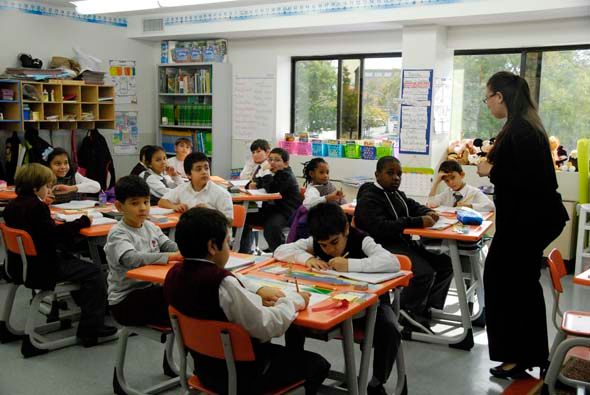Op-Ed: Divisive Teacher Evaluations Could Lead To Better Public Education

As midwinter recess for New York City public schools wrapped up last week, evaluations for 18,000 teachers were released. Some teachers were likely enjoying the break and paid no attention to the news, but the topic of conversation in teachers’ lounges across the city on Monday surely focused more on the data reports than what they did on vacation.
After months of debate, legal skirmishes and fierce opposition from the teacher’s union, which has argued the new evaluations paint an unfair and incomplete picture of teacher effectiveness, the reports were released last Friday in response to a Freedom of Information request by several news organizations. The data, however, only appraised about 20 percent of teachers in grades 4 through 8 in reading and math. The reports identify successful teachers, struggling teachers and those who can’t seem to help failing students and perhaps should be removed.
Due to pressure from Governor Andrew Cuomo, who vowed to offer his own proposal if the impasses were not resolved, the evaluations system has undergone a major reform. For better or worse, the changes probably won’t be accurately assessed for years, but, for now, the winds of change are gusting through public school hallways.
It’s easy to see why the union and teachers object to a method that gauges teacher effectiveness, as opposed to prior ratings that habitually gave 97 percent of city teachers a “satisfactory.”
On the other hand, correctly analyzed teacher evaluations could prove to be an indispensable factor in transforming public education.
New York City’s teachers’ union has exerted too much influence for too long, as it showed more concern for wages and benefits than recommending input to enhance the quality of education.
Under the new system, teachers will be ranked ineffective, developing, effective or highly effective. Under the current system unsatisfactory or satisfactory are the only ratings.
“Ineffective” teachers will subsequently be required to follow a plan to deal with rated weaknesses. They will be monitored by principals and outside observers. If observers support the principals’ findings, the city could fire the teacher for incompetence. Under current standards, the city has the burden of proof, making dismissal much more difficult.
For the first time, all school districts will have to stick to demanding guidelines to assess teachers and principals, using a scoring system intended to take into account performance and student achievement. The union will no longer be able to defend unsuccessful teachers and keep them on the job due to contracts that were negotiated under deadline pressures.
Even so, the unions aren’t the only culprits to blame for the problems that inhibited progress. When the schools were operated by the defunct Board of Education, decades of mismanagement and overlooked waste preoccupied its managers, as students and schools suffered. With the makeover and name change to the Department of Education, some progress is evident, but there’s still a long way to go in a process that keeps evolving.
Furthermore, while many parents and guardians welcome the evaluations, they must also assume responsibility to ensure a student’s education doesn’t end when the school day does. They also bear accountability in a child’s education and must make a concerted effort to make certain a child uses sufficient time at home and after school to supplement classroom work.
After all, teachers are not glorified babysitters or temporary child custodians. If they have to constantly discipline a few troublemakers and contain unnecessary distractions, the rest of the class suffers and is ultimately deprived of time to learn.
While the teacher evaluation system has its flaws and shortcomings — as does the education system — it is a means to expose and get rid of educators who may not be as committed as they need to be when they have scores of young minds in their control.
For those teachers who dread the new evaluation system because it may expose their deficiencies, it’s perhaps time they retired and collected comfortable pensions, because they may have been doing more harm than good for those students whose intellectual curiosity and creativity went unfulfilled.
Above all, teachers who do their jobs with appropriate degrees of commitment and responsibility shouldn’t be concerned because the results will demonstrate their efforts and hard work. On the other hand, their peers, who may be getting by just by showing up, might soon learn that they are in for a conspicuous wake up call.
At last, the union’s hands are tied and it won’t be able to keep the apples polished for the rotten ones in the education barrel.
Neil S. Friedman is a veteran reporter and photographer, and spent 15 years as an editor for a Brooklyn weekly newspaper. He also did public relations work for Showtime, The Rolling Stones and Michael Jackson. Friedman contributes occasional columns on life, culture and politics in Sheepshead Bay.




